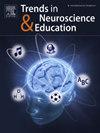Neural responses to errors in models and their relevance for longer term learning among undergraduate life sciences students
IF 3.4
Q2 NEUROSCIENCES
引用次数: 0
Abstract
Background
Error detection and inhibition are deemed central to STEM learning, although there is little research on the neural bases of these processes and their role in the developing expertise of life sciences students.
Method
Fifty undergraduate life sciences students performed a biology model evaluation task and a general go/no-go inhibition task during functional MRI. A year later, they completed a biology model evaluation task outside the scanner.
Results
Students showed increased ACC and bilateral inferior frontal/insula activity when viewing models with, vs. without, conceptual errors. Multivariate activation patterns showed little correspondence across the fMRI model and go/no-go tasks. Functional connectivity between the ACC and lateral PFC correlated with course grades, while activity in the right inferior frontal gyrus/insula predicted later model evaluation performance.
Conclusions
Students who activate lateral PFC regions during scientific error detection may show better concept retention, although this neural activity may not reflect inhibitory control.
生命科学本科生对模型错误的神经反应及其与长期学习的相关性
错误检测和抑制被认为是STEM学习的核心,尽管关于这些过程的神经基础及其在发展生命科学学生专业知识中的作用的研究很少。方法50名生命科学专业本科生在功能MRI期间进行生物模型评估任务和一般go/no-go抑制任务。一年后,他们在扫描仪外完成了一项生物模型评估任务。结果学生在观看有或没有概念错误的模型时,ACC和双侧额叶下/脑岛活动增加。多变量激活模式在fMRI模型和去/不去任务之间显示出很少的对应关系。ACC和外侧PFC之间的功能连通性与课程成绩相关,而右侧额下回/脑岛的活动预测了后期模型评估的表现。结论在科学错误检测过程中激活PFC侧区的学生可能表现出更好的概念保留,尽管这种神经活动可能不反映抑制控制。
本文章由计算机程序翻译,如有差异,请以英文原文为准。
求助全文
约1分钟内获得全文
求助全文
来源期刊

Trends in Neuroscience and Education
NEUROSCIENCES-
CiteScore
6.30
自引率
6.10%
发文量
22
审稿时长
65 days
 求助内容:
求助内容: 应助结果提醒方式:
应助结果提醒方式:


